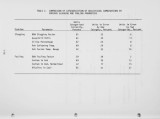| OCR Text |
Show EVALUATING SLAGGING AND FOULING PARAMETERS R. E. Barrett, J. M. Murin, G. A. Mack, and J. Dimmer INTRODUCTION Coals contain inert materials which are liberated as ash upon combustion of the coals. In pulverized coal-fired boilers, where the finely ground coal is suspended in air and blown into the frame, the majority of the ash is carried from the furnace suspended in the combustion products. However, some fraction of ash comes into contact with furnace and boiler surfaces and adheres to those surfaces. As the quantity of ash intorduced into a boiler furnace can be large*, retention of even a small fraction of the ash on tube surfaces can seriously interfere with heat transfer and upset boiler operation. As long as the ash deposits remain dry and weakly bonded, they are not too troublesome. If an adequate number of wall blowers and soot blowers are available, the dry and weakly bonded deposits can be removed as necessary, and boiler operation can continue. However, if the ash deposits become strongly bonded to the tubes, either as sintered, plastic, or molten material, they may be difficult or impossible to remove by wall blower or soot blower operation. If deposits cannot be removed at high load, the load on the boiler may have to be reduced so that furnace temperatures are lowered to the point where wall and/or soot blowers are effective. It is not unusual to observe power plants that must drop loads to about one-third of capacity at night to shed slag accumulated during high-load daytime operation. Boiler deposit problems are classified as slagging and fouling, where different persons use somewhat different definitions for these terms. For purposes of this paper, slagging is defined as deposit problems within the furnace and on widely spaced pendant superheater tubes. Fouling is defined as deposit problems on the more closely spaced convection tubes-- superheater tubes, reheater tubes, and even economizer tubes. * A 300 MW unit firing 12,500 Btu/lb, 10 percent ash coal will be exposed to 24,000 lb of ash per hour. 1-2 |






























